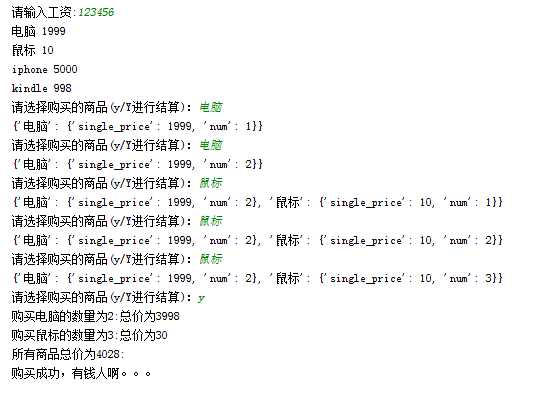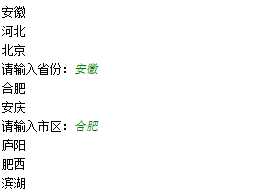python基本數據類型練習
阿新 • • 發佈:2018-01-26
num 價格 安慶 bubuko 需要 price 結算 mage pri
一、元素分類
# 有如下值集合 [11,22,33,44,55,66,77,88,99,90...],將所有大於 66 的值保存至字典的第一個key中,將小於 66 的值保存至第二個key的值中。
# 即: {‘k1‘: 大於66的所有值, ‘k2‘: 小於66的所有值}
list1 = [11,22,33,44,55,66,77,88,99,90]
dic1 = {
‘k1‘:[],
‘k2‘:[]
}
for l in list1:
if l > 66:
dic1[‘k1‘].append(l)
else:
dic1[‘k2‘].append(l)
print(dic1) 二、查找
1、 查找列表中元素,移除每個元素的空格,並查找以 a或A開頭 並且以 c 結尾的所有元素
li = ["alc", " aric ", "Aex", "Tny", "rain"]
list1 =[]
for l in li:
#使用strip方法確定能尋找到所有元素,startwith,endwith按條件進行查找
if l.strip().startswith(‘a‘or ‘A‘) and l.strip().endswith(‘c‘):
#print(l.strip())
list1.append(l.strip())
print(list1)2、元組
tu = ("alc", " aric", "Alx", "Tny", "rain")
#找出的元素放到一個新列表中,因為元組中不能增加元素
list2 =[]
for l in tu:
#使用strip方法確定能尋找到所有元素,startwith,endwith按條件進行查找
#if 判斷遇到or和and是需要註意執行成功時的判斷
if l.strip().startswith(‘a‘or ‘A‘) and l.strip().endswith(‘c‘):
#print(l.strip())
list2.append(l.strip())
print(list2)
3、字典
dic = {‘k1‘: "alx", ‘k2‘: ‘ aric‘, "k3": "Alx", "k4": "Tny","k5":" Anc "}
#定義一個空字典
dic1 = {}
for k,v in dic.items():
if (v.strip().startswith(‘a‘) or v.strip().startswith(‘A‘)) and v.strip().endswith(‘c‘):
print(v)
dic1[k] =v
print(dic1)
三、輸出商品列表,用戶輸入序號,顯示用戶選中的商品
# 商品
li = ["手機", "電腦", ‘鼠標墊‘, ‘鍵盤‘]
for num,v in enumerate(li,1):
print(num,v)
choice = int(input("請選擇商品:"))
choice1=choice-1
if choice1>=0 and choice1<=len(li)-1:
print(li[choice1])
else:
print("商品不存在")
四、購物車
# 功能要求:
# 要求用戶輸入總資產,例如:2000
# 顯示商品列表,讓用戶根據序號選擇商品,加入購物車
# 購買,如果商品總額大於總資產,提示賬戶余額不足,否則,購買成功。
# 附加:可充值、某商品移除購物車
方法一:
goods = [
{"product": "電腦", "price": 1999},
{"product": "鼠標", "price": 10},
{"product": "iphone", "price": 5000},
{"product": "kindle", "price": 998},
]
#已經買到的商品
list_buy = []
#輸入總資產
all_money = 0
all_money = int(input("請輸入總資產:"))
#輸出所有的產品
for key,i in enumerate(goods,1):
print(i[‘product‘],i[‘price‘])
#當條件成立時,在購買環節循環
while True:
#選擇需要買的商品
choice = input("請選擇商品(y/Y進行結算購買):")
#是否進行結算
if choice.lower() == "y":
break
#循環所有的商品與選擇商品進行對比,如果存在,就添加到list_buy中
for v in goods:
if choice == v["product"]:
list_buy.append(v)
#輸出所有打算購買的商品
print(list_buy)
#定義商品總價初始值
total_price = 0
for p in list_buy:
#計算所有商品價格
total_price = total_price+p["price"]
if total_price>all_money:
print("你的錢不夠,請充值%d元"%(total_price-all_money))
chongzhi = int(input("輸入充值金額:"))
all_money +=chongzhi
else:
print("購買成功")
print(list_buy)
方法二:
goods = [
{"product": "電腦", "price": 1999},
{"product": "鼠標", "price": 10},
{"product": "iphone", "price": 5000},
{"product": "kindle", "price": 998},
]
salary = int(input("請輸入工資:"))
#dic_shop_cart = {"product":{"price":0,"num":0}}
dic_shop_cart = {}
#循環輸出所有產品
for p in goods:
print(p[‘product‘],p[‘price‘])
while True:
choice = input("請選擇購買的商品(y/Y進行結算):")
if choice.lower() == ‘y‘:
break
#循環所有商品
for item in goods:
#判斷選擇的商品是否在所有商品中
if item["product"] == choice:
#如果存在,就把商品賦值給product
product = item["product"]
#如果商品在字典dic_shop_cart中,字典中num就加1
if product in dic_shop_cart.keys():
dic_shop_cart[product]["num"] = dic_shop_cart[product]["num"] + 1
#如果不在,就第一次添加到字典中
else:
dic_shop_cart[product] = {"num":1,"single_price":item["price"]}
print(dic_shop_cart)
sum_price = 0
for k,v in dic_shop_cart.items():
# print(k,v)
t_price = v["single_price"]*v["num"]
print("購買%s的數量為%s:總價為%d"%(k,v["num"],t_price))
sum_price=sum_price+t_price
print("所有商品總價為:%s"%sum_price)
if sum_price>salary:
print("你的錢不夠,哈哈哈。。。,別買了吧")
else:
print("購買成功,有錢人啊。。。")
輸出結果:

五、用戶交互,顯示省市縣三級聯動的選擇
dic = {
"河北": {
"石家莊": ["鹿泉", "槁城", "元氏"],
"邯鄲": ["永年", "涉縣", "磁縣"],
},
"北京": {
"大興": ["黃村", "清源", "天宮院"],
"海澱": ["中關村", "西二旗", "五道口"],
},
"安徽": {
"合肥": ["廬陽", "肥西", "濱湖"],
"安慶": ["桐城", "宜秀區", "嶽西"],
}
}
for p in dic:
print(p)
p1 = input("請輸入省份:")
if p1 in dic.keys():
for s in dic[p1]:
print(s)
s1 = input("請輸入市區:")
if s1 in dic[p1].keys():
for q in dic[p1][s1]:
print(q)
else:
print("市區還沒有錄入")
else:
print("省份還沒有錄入")
執行結果:

python基本數據類型練習
